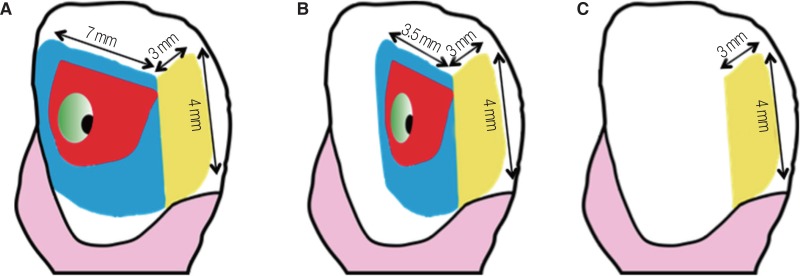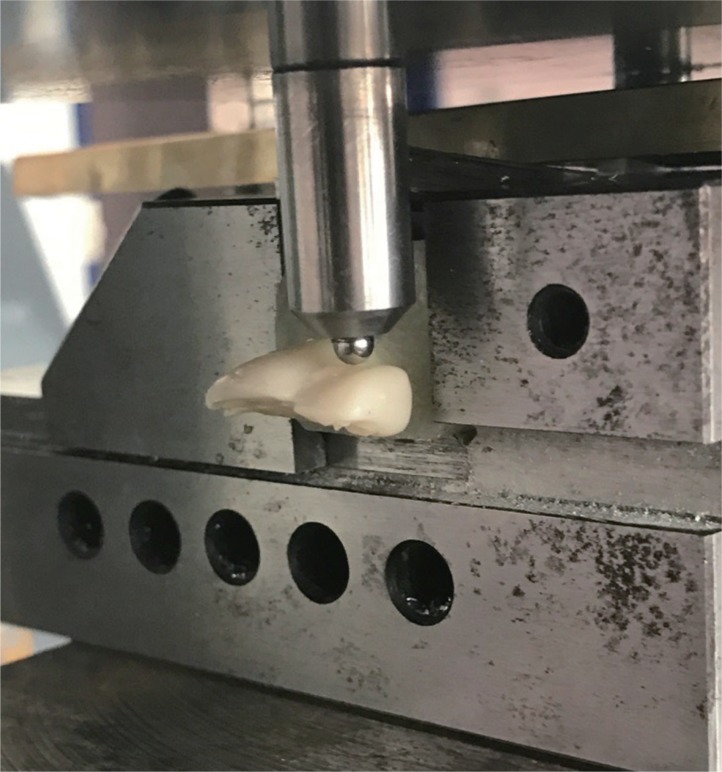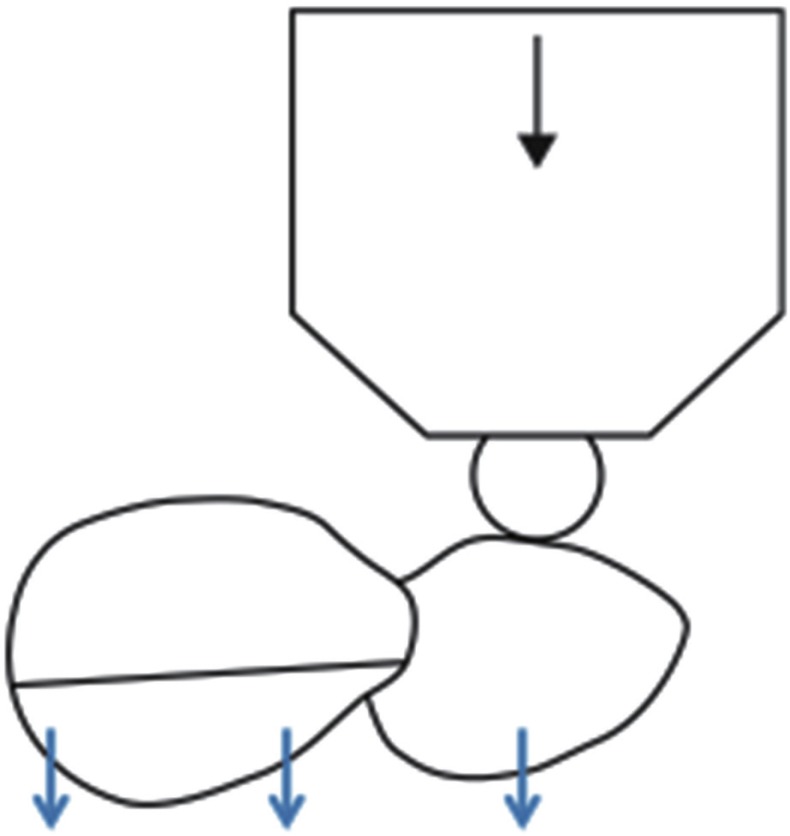J Adv Prosthodont.
2018 Aug;10(4):286-290. 10.4047/jap.2018.10.4.286.
Influence of the amount of tooth surface preparation on the shear bond strength of zirconia cantilever single-retainer resin-bonded fixed partial denture
- Affiliations
-
- 1Department of Stomatology and Dentistry, Erasmus Hospital, Université Libre de Bruxelles, Brussels, Belgium. Sibel.Cetik@ulb.ac.be
- 2Laboratory of Physiology and Pharmaceutics, Faculty of Medicine, Université Libre de Bruxelles, Brussels, Belgium.
- KMID: 2418634
- DOI: http://doi.org/10.4047/jap.2018.10.4.286
Abstract
- PURPOSE
Conventional resin-bonded fixed partial dentures (RBFPDs) are usually made with a two-retainer design. Unlike conventional RBFPDs, cantilever resin-bonded fixed partial dentures (Cantilever RBFPDs) are, for their part, made with a single-retainer design. The aim of this study was to compare the effect of tooth surface preparation on the bond strength of zirconia cantilever single-retainer RBFPDs. The objective is to evaluate the shear bond strength of these single-retainer RBFPDs bonded on 3 different amount of tooth surface preparation.
MATERIALS AND METHODS
Thirty extracted bovine incisors were categorized to 3 groups (n=10), with different amounts of tooth surface preparations. Teeth were restored with single-retainer RBFPDs with different retainer surfaces: large retainer of 32 mm²; medium retainer of 22 mm²; no retainer and only a proximal connecting box of 12 mm². All RBFPDs were made of zirconia and were bonded using an adhesive system without adhesive capacity. Shear forces were applied to these restorations until debonding.
RESULTS
Mean shear bond strength values for the groups I, II, and II were 2.39±0.53 MPa, 3.13±0.69 MPa, and 5.40±0.96 MPa, respectively. Statistical analyses were performed using a one-way ANOVA test with Bonferroni post-hoc test, at a significance level of 0.001. Failure modes were observed and showed a 100% adhesive fracture.
CONCLUSION
It can be concluded that the preparation of large tooth surface preparation might be irrelevant. For zirconia single-retainer RBFPD, only the preparation of a proximal connecting box seems to be a reliable and minimally invasive approach. The differences are statistically significant.
Keyword
MeSH Terms
Figure
Reference
-
1. Kern M. Clinical long-term survival of two-retainer and single-retainer all-ceramic resin-bonded fixed partial dentures. Quintessence Int. 2005; 36:141–147. PMID: 15732550.2. Pjetursson BE, Tan WC, Tan K, Brägger U, Zwahlen M, Lang NP. A systematic review of the survival and complication rates of resin-bonded bridges after an observation period of at least 5 years. Clin Oral Implants Res. 2008; 19:131–141. PMID: 18070120.
Article3. Hussey DL, Pagni C, Linden GJ. erformance of 400 adhesive bridges fitted in a restorative dentistry department. J Dent. 1991; 19:221–225. PMID: 1787210.4. Durey KA, Nixon PJ, Robinson S, Chan MF. esin bonded bridges: techniques for success. Br Dent J. 2011; 211:113–118. PMID: 21836574.5. Kern M, Barloi A, Yang B. urface conditioning influences zirconia ceramic bonding. J Dent Res. 2009; 88:817–822. PMID: 19767578.6. Botelho M. esign principles for cantilevered resin-bonded fixed partial dentures. Quintessence Int. 2000; 31:613–619. PMID: 11203985.7. Djemal S, Setchell D, King P, Wickens J. ong-term survival characteristics of 832 resin-retained bridges and splints provided in a post-graduate teaching hospital between 1978 and 1993. J Oral Rehabil. 1999; 26:302–320. PMID: 10232858.8. Chan AW, Barnes IE. A prospective study of cantilever resin-bonded bridges: an initial report. Aust Dent J. 2000; 45:31–36. PMID: 10846270.9. Olin PS, Hill EM, Donahue JL. Clinical evaluation of resin-bonded bridges: a retrospective study. Quintessence Int. 1991; 22:873–877. PMID: 1812510.10. Bassi GS, Youngson CC. An in vitro study of dentin exposure during resin-bonded fixed partial denture preparation. Quintessence Int. 2004; 35:541–548. PMID: 15259969.
Article11. Kern M, Sasse M. Ten-year survival of anterior all-ceramic\resin-bonded fixed dental prostheses. J Adhes Dent. 2011; 13:407–410. PMID: 21935512.12. van Dalen A, Feilzer AJ, Kleverlaan CJ. A literature review of two-unit cantilevered FPDs. Int J Prosthodont. 2004; 17:281–284. PMID: 15237872.
- Full Text Links
- Actions
-
Cited
- CITED
-
- Close
- Share
- Similar articles
-
- Clinical perspectives on 2-unit cantilevered resin-bonded fixed partial denture
- Resin bonded fixed prosthesis for single tooth restoration: A case report
- Effect of thermocycling on shear bond strength and mode of failure of bonded retainer using flowable composite resin
- Zirconia resin-bonded fixed partial denture in maxillary single-tooth edentulous area: A case report
- Resin-bonded fixed partial denture using In-Ceram and Targis-Ventris system




